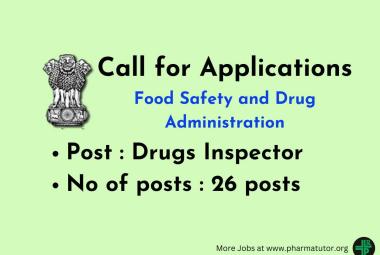 About Authors: Arun Kumar Dash*, Suchismita Jena, Sudhir Kumar Sahoo
About Authors: Arun Kumar Dash*, Suchismita Jena, Sudhir Kumar Sahoo
Department of Pharmaceutical Analysis and Quality Assurance
Royal College of Pharmacy and Health Sciences,
Andhapasara Road Berhampur, Odisha
Reference ID: PHARMATUTOR-ART-1040
ABSTRACT
A simple method for the estimation of Pioglitazone in bulk and pharmaceutical dosage forms has been developed. 0.1N HCl was chosen as the solvent system. The λmax was found to be 270nm and all absorbance values were carried out at 270nm. The responses were linear in the range of 5-100µg/ml. The regression equation of the calibration graph and correlation coefficient were found to be y = 0.026x - 0.020 and 0.999 respectively. The %RSD values for both intraday and interday precision were less than 1%. The recovery of the drug from the sample was ranged between 99.36 and 100.49%. The proposed method was validated for precision, accuracy, intraday, interday assay, robustness and ruggedness. Commercial tablets containing 20mg and 40mg of Pioglitazone were analyzed by the proposed method and the results were well within the claimed limits. Furthermore the effect of pH on Pioglitazone was studied.
[adsense:336x280:8701650588]
INTRODUCTION
Pioglitazone (figure I) is thiazolidinedione (TZD) class of drug with hypoglycemic, antihyperglycemic and antidiabetic action. Chemically Pioglitazone is (RS)-5-(4-[2-(5-ethylpyridin-2-yl)ethoxy]benzyl)thiazolidine-2,4-dione. Pioglitazone is used for the treatment of diabetes mellitus type 2 (previously known as non-insulin-dependent diabetes mellitus, NIDDM) in monotherapy and in combination with a sulfonylurea, Metformin. Pioglitazone has also been used to treat non-alcoholic fatty liver. Pioglitazone has also been found to reduce the risk of conversion from prediabetes to diabetes mellitus type 2 by 72%. A literature survey reveals that there are various methods available for estimation of Pioglitazone like, HPLC1,2,3,4 , LC-MS-MS5, capillary electrophoresis6. However some of these methods are costlier, time consuming and are only for estimation of drugs from the biological fluids. Also the above methods are not validated for its performance under stress conditions thus rendering them unsuitable for stability studies. Thus an attempt was made to develop a new, simple, accurate and validated method for determination of Pioglitazone by UV spectrophotometric method along with its pH stability studies. The method was validated as per the procedures and acceptance criteria of ICH guidelines.
MATRIALS AND METHOD
Instruments: All the chemicals and reagents used were of analytical grade (AR) procured from Merck. All absorbance measurements were done with Shimadzu 1700 double beam UV-Spectrophotometer (Japan) with 10mm matched quartz cell and Borosil glass wares were used for the study. All weighing was done on Sartorious BT 2245 electronic balance.
Standard Stock Solution: Standard stock solution was prepared by dissolving 10 mg of drug in 10ml of 0.1N HCl to get a concentration of 1000 µg/ml. It was further diluted to get a concentration of 100 μg/ml. and was kept as the stock solution.
Determination of λmax: The standard solution of Pioglitazone (10 µg/ml) was scanned in the wavelength region of 200-400 nm and the λmax was found to be 270 nm.
Preparation of calibration curve: The stock solution of Pioglitazone was according diluted to obtain concentration in the range of 05-100μg/ml. The absorbances were observed against 0.1N HCl as blank and the calibration curve was plotted between concentration (x-axis) and absorbance (y-axis).
Assay of tablet dosage form:
20 tablets of brand PIOZ (manufactured by US Vitamins Limited.) containing 15 mg of Pioglitazone were weighed, average weight determined and finely crushed to powder. An accurate weight equivalent to 10mg of the drug was transferred to 100ml volumetric flask. The drug was extracted 4 times by adding solvent in potions, 20 ml each time and the volume was made upto the mark by using solvent. It was then diluted (within the linearity range), absorbances of the sample solution were recorded at determined λmax and the concentration of the drug in sample was found out. In a similar manner, the assay of GLIZONE (manufactured by Zydus Cadila HealthcareLtd.)containing 30mg of Pioglitazone was carried out.
VALIDATION
1. Accuracy: The accuracy of the proposed method was tested by recovery studies at 80%, 100%, and 120% by adding a known amount of pure drug to the pre-analyzed formulation of concentration 10µg/ml.
2. Precision: The precision of the proposed method was ascertained by actual determination of 6 replicates of a fixed concentration of the drug (10µg/ml) within the Beer’s range and finding out the absorbance by the proposed method.
3. Intraday Assay: The intraday assay of the proposed method was ascertained by actual determination of 6 replicates of a fixed concentration of the drug (10µg/ml) within the Beer’s range and finding out the absorbance by the proposed method at 3 different time period of the same day.
4. Interday Assay: The interday assay of the proposed method was ascertained by actual determination of 6 replicates of a fixed concentration of the drug (10µg/ml) within the Beer’s range and finding out the absorbance by the proposed method on 3 different days.
pH DEGRADATION STUDIES: The pH effect on the drug was carried out by using 0.1N Hydrochloric acid, 2N Hydrochloric acid, 0.1N Sodium Hydroxide and 2N Sodium Hydroxide solution. The drug solutions (20µg/ml) from pH 0-14 were prepared in the manner as shown in table 1 and these were allowed to stands for 4 hours. Finally the absorbances were measured at 270nm. The K value for 1st order kinetics was determined by using the formula:
K= (2.303/t) log (Co/C)
Where K=1st order rate constant, Co. =initial drug concentration, C=final drug concentration
Table 1: Preparation of sample solution of pH 0-14 for pH stability
|
pH |
Amount of Drug solution added (100 µg/ml) in ml |
Amount of 0.1N NaOH solution added(ml) |
Amount of HCl added in ml |
|
0 |
2.5 |
2.5 |
12.5 of 2N HCl |
|
1 |
2.5 |
2.5 |
1.25 of 2N HCl |
|
2 |
2.5 |
2.5 |
1.25 of 0.2N HCl |
|
3 |
2.5 |
2.5 |
1.25 of 0.02N HCl |
|
4 |
2.5 |
2.5 |
1.25 of 0.002N HCl |
|
5 |
2.5 |
2.5 |
1.25 of 0.002N HCl |
|
6 |
2.5 |
2.5 |
1.25 of 0.002N HCl |
|
7 |
2.5 |
2.5 |
|
|
8 |
2.5 |
2.5 |
12.5 of 2N NaOH |
|
9 |
2.5 |
2.5 |
1.25 of 2N NaOH |
|
10 |
2.5 |
2.5 |
1.25 of 0.2N NaOH |
|
11 |
2.5 |
2.5 |
1.25 of 0.02N NaOH |
|
12 |
2.5 |
2.5 |
1.25 of 0.002N NaOH |
|
13 |
2.5 |
2.5 |
1.25 of 0.0002N NaOH |
|
14 |
2.5 |
2.5 |
1.25 of 0.00002N NaOH |
RESULTS AND DISCUSSION:
a. Calibration Curve: The absorbance for the different concentrations (05-100μg/ml) was recorded at 290nm. The calibration curve (figure II) data is shown in table 2. The assay results of the marketed formulations are shown in table 3.
b. Accuracy:The % recovery was found to be in the range of 99.04 and 101.09%.
c. Precision:The %RSD for precision was found to be 0.418899
d. Intraday and Interday Assay: The %RSD for Intraday and Interday Assay were found to be 0.231323 and 0.24638respectively. Low values of %RSD indicate that the proposed method is accurate.
e. pH Stability Results: The result obtained in the pH degradation is given in figure III and represented in table no. 4. Further studies are depicted in figure IV, V and VI.
Table 2: Standard Curve of Pioglitazone at 270nm
|
Concentration |
Absorbance |
|
05 10 15 20 25 30 35 40 45 50 55 60 65 70 75 80 85 90 95 100 |
0.126 0.259 0.382 0.516 0.641 0.773 0.905 1.045 1.198 1.305 1.432 1.589 1.702 1.856 1.987 2.112 2.264 2.385 2.511 2.668 |
Table 3: Assay result of the marketed formulation by the proposed method
|
Formulation Label claimed Observed Amount % Recovery |
|
PIOZ 15mg 14.77 98.47 GLIZONE 30mg 29.36 97.87 |
Table 4:pH Degradation Results:
|
PH |
ABSORBANCE (at 270 nm) |
CONCENTRATION (µg/ml) |
% DRUG DEGRADED |
k VALUE |
Log k |
|
0 |
0.45 |
17.1103 |
14.45 |
0.039 |
-1.4089 |
|
1 |
0.452 |
17.1863 |
14.07 |
0.0379 |
-1.4214 |
|
2 |
0.449 |
17.0722 |
14.64 |
0.0396 |
-1.4023 |
|
3 |
0.458 |
17.4144 |
12.93 |
0.0346 |
-1.4609 |
|
4 |
0.458 |
17.4144 |
12.93 |
0.0346 |
-1.4609 |
|
5 |
0.502 |
19.0875 |
4.56 |
0.0117 |
-1.9318 |
|
6 |
0.521 |
19.8099 |
0.95 |
0.0024 |
-2.6198 |
|
7 |
0.515 |
19.5817 |
2.09 |
0.0053 |
-2.2757 |
|
8 |
0.508 |
19.3156 |
3.42 |
0.0087 |
-2.0605 |
|
9 |
0.499 |
17.0722 |
14.64 |
0.0396 |
-1.4203 |
|
10 |
0.422 |
16.0456 |
19.77 |
0.0551 |
-1.2588 |
|
11 |
0.392 |
14.9049 |
25.48 |
0.0735 |
-1.1337 |
|
12 |
0.378 |
14.3726 |
28.14 |
0.0826 |
-1.083 |
|
13 |
0.342 |
13.0038 |
34.98 |
0.1076 |
-0.9682 |
|
14 |
0.331 |
12.5856 |
37.07 |
0.1158 |
-0.9363 |
CONCLUSION:
The proposed method was found to be simple, precise and rapid for the determination of Pioglitazone from pure and its dosage forms. The sample recoveries in all formulations were in good agreement with their respective label claims. Thus the proposed method can be used as an alternative method to the reported ones for the routine analysis of the drug in bulk and pharmaceutical dosage forms and can also be used for dissolution or similar studies.
Further, it was observed that there is clearly specific acid –base catalysis in the acidic or basic range for Pioglitazone HCl; degrading more rapidly in alkaline pH in comparision to acidic pH. There is a pH independent region between pH 5-8. So, we can conclude that at pH range 5 - 8, Pioglitazone formulation will remain stable. Thus by adding buffer which provides the specified pH range, the shelf life of Pioglitazone formulation can be increased
REFERENCES:
1. S. Sayed, A. Thomas. RP-HPLC method development for determination of Pioglitazone hydrochloride from tablets. Journal of Pharmacy Research. 2009, 2(9), 1479-1480.
2. A. Jedlieka, J. Klime, Grafnetterova T. Reversed-phase HPLC methods for purity test and assay of Pioglitazone hydrochloride in tablets. Pharmazie., 2004.59, 178-182.
3. Radhakrishna T., Sreenivas R.D., Determination of Poglitazone hydrochloride in bulk and pharmaceutical formulations by HPLC and MEKC methods J. Pharma. Biomed. Anal., 2002, 29, 593.
4. Y.Kenji, M. Hiromi, O. Teruaki. High-performance liquid chromatographic determination of Pioglitazone and it metabolites in human serum and urine. J Chromatorgr. B., 1996,677,141.
5. BASi library database [https://www.basinc.com/library/presentations/biochem/pugh_01/]
6. B Jamal, G C Theill. Generic, highly selective and robust capillary electrophoresis method for separation of a racemic mixture of glitazone compounds. Journal of Chromatography A.,2004,1049, 183-187
FIND OUT MORE ARTICLES AT OUR DATABASE









